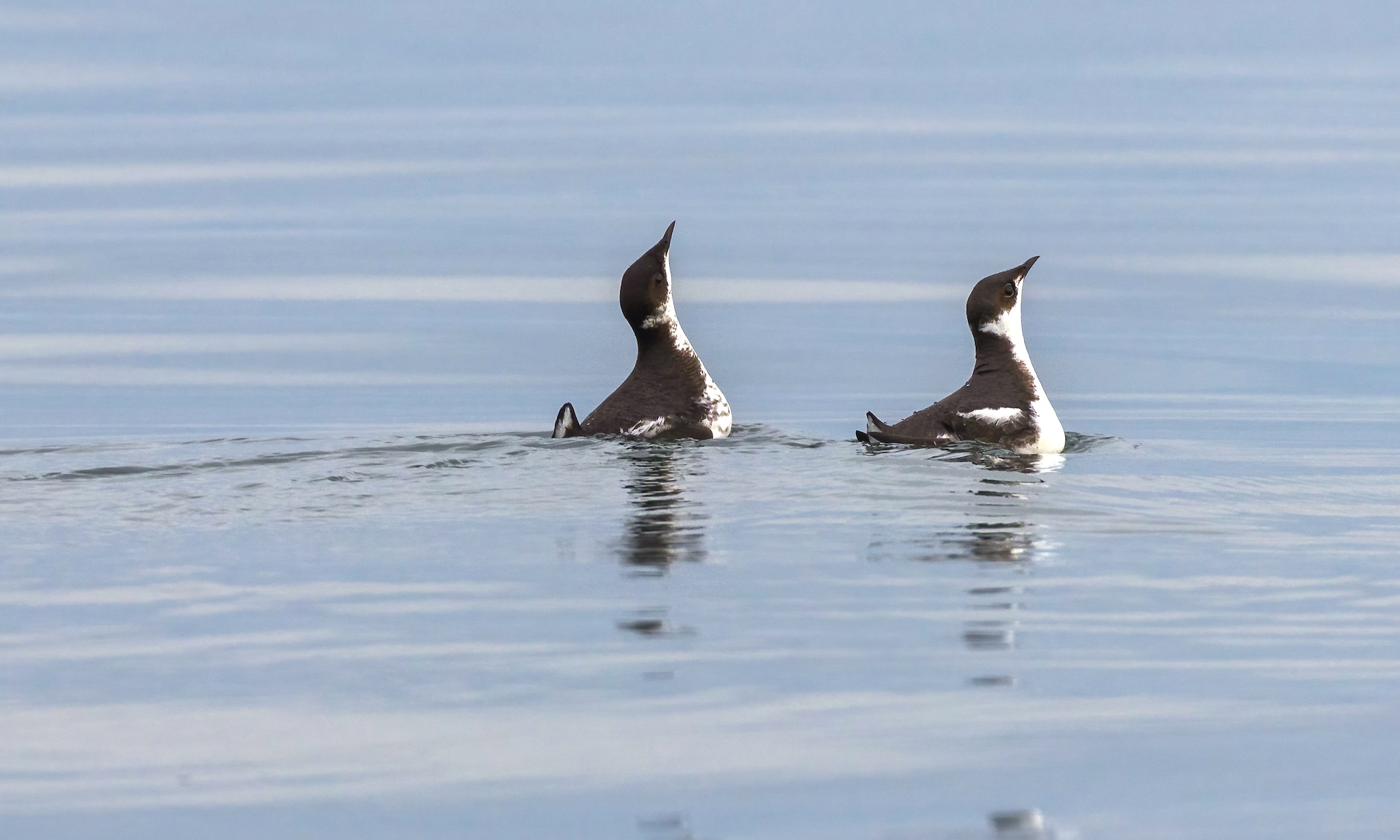Picking callsigns for the two inflatable boats is a challenge at first.
“How about Marbled for one and Murrelet for the other?” someone suggests.
“Might be a little hard to tell those apart on the radio,” says Scott Pearson, a biologist with the Washington Department of Fish and Wildlife. He mulls a moment. “What about MAMU One and MAMU Two?” MAMU is a kind of birdwatcher’s shorthand for the MArbled MUrrelet — the subject of the night’s festivities, if that isn’t clear by now.
Some murmuring among the company.
“What about Gray Boat and Red Boat?” says Kwasi Addae, another WDFW biologist who usually works with salmon, but tonight will captain Fog Lark, a larger research boat and our mothership.
Everyone agrees Gray Boat and Red Boat are superior, since the boats are, as it happens, gray and red. With that, we all continue our preparations, stowing dry bags of gear, wriggling into Mustang survival suits. We are at the Port Hadlock marina, at the southern end of Port Townsend Bay. Although it is not even 5 p.m., we are well into the cool blush of January twilight.
Soon we are ready, and Addae pilots Fog Lark through the channel between Indian Island and the mainland, and out into Puget Sound proper, towing Gray Boat and Red Boat behind. When we reach the appointed spot off of Marrowstone Island, six of us will split up and set off in the inflatables, leaving two people on Fog Lark. We each have an assigned role — driver, spotlighter, netter. I am to be the netter in Red Boat. This means that, should we see a marbled murrelet paddling the waters of Puget Sound and get close enough to it, I will be responsible for ensnaring it in the large dipnet currently propped in the back of Red Boat.
So strong is the murrelets’ need for big old conifers that some of them will nest more than forty miles inland, flying in and out every day to bring food to their waiting chick.
I have never done this before, so I ask Pearson, who is leading this effort, if he has any pointers. He sure does: the approach in the inflatable will be slow but steady, and I should hold the net low, just under the surface of the water, if I can, while being careful to brace the pole against my arm so as not to let the boat’s momentum tear the net from my hands, until I’ve got the net right under the murrelet, and then I should scoop it up with a quick sharp motion before the bird can dive or fly away, taking care to flip the net just so to trap the bird in a kind of pocket.
All of this could take place in five to ten seconds.
“Got it?” Pearson asks.
“Got it,” I say, although I definitely do not got it. “How many murrelets do you think we’ll catch?” I have to confess that I worry the murrelets will be coming so thick and fast that I won’t be able to keep up.
“Oh, I don’t know,” Pearson says, and chuckles. “We’ll be lucky if we even see one.”
Forest to the sea
Marbled murrelets are small auks, or alcids, that as adults are a little less than ten inches in length, with short stubby wings and slender black bills. The species lives more or less year-round on the northwestern coast of North America between central California and southern Alaska. They get their name from their breeding plumage, which is brown but flecked with white throughout, so that the birds look like a fine piece of stone. In the winter, adults lose that mottling, becoming basically black on top and white on the throat and belly.
Marbled murrelets are pursuit divers, meaning they dive for their prey, propelling themselves underwater with quick strong strokes of their wings. Their preferred food are small fish, but they are opportunistic and will eat marine invertebrates if fish are scarce. It is where they like to nest, though, that gets the most attention, especially in California, Oregon, and Washington. In these parts of the Pacific Northwest marbled murrelets nest only in trees, and their preference tends to old growth. Every spring, females lay a single egg in a little mossy cup on a thick high branch. So strong is the murrelets’ need for big old trees that some of them will nest more than forty miles inland, flying in and out every day to bring food to their waiting chick.
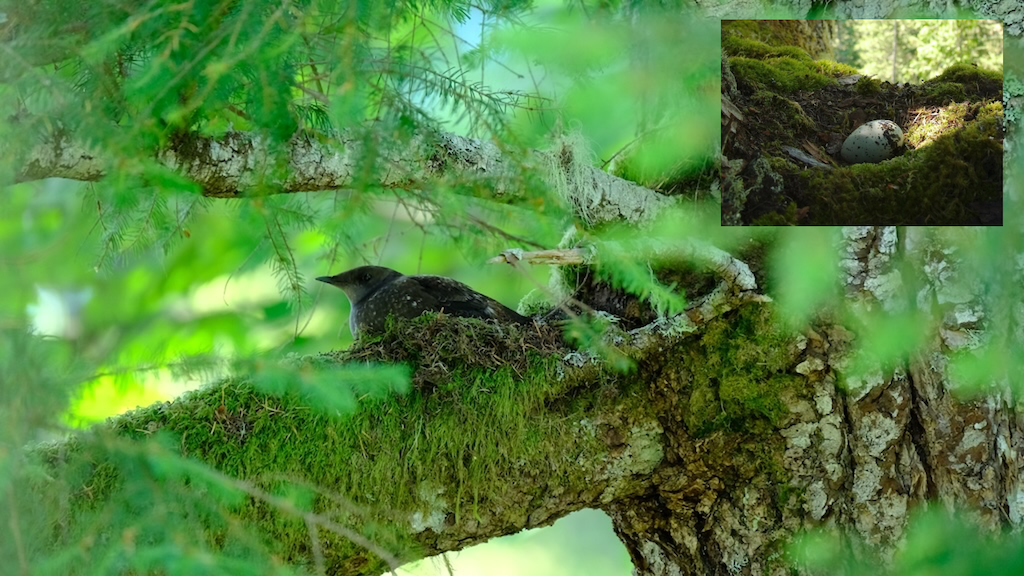
Marbled murrelets prefer to nest in old growth forests where females lay a single egg in a mossy depression on a high branch. Photos: (Nesting murrelet) copyright Brett Lovelace/Oregon State University; (egg in nest) Nick Hatch/ USDA
One need not be intimately familiar with the ins and outs of forest management in the western Cascade Range and on the Olympic Peninsula to know that not a lot of old growth acreage remains. As those trees have disappeared, so, too, have the murrelets. By the late 1980s, their population along the west coast was thought to have declined from well over 60,000 pairs to fewer than 10,000. The species was federally listed as threatened under the Endangered Species Act in Washington, Oregon, and California in 1992, and with that came a legal obligation to understand the causes of the decline, if not address them.
So we have come out tonight as part of a multi-pronged, U.S. Navy/U.S. Fish and Wildlife Service-funded project to characterize how marbled murrelets are using one small part (Puget Sound) of a larger political space (Washington state) along a vast coastal segment (much of the west coast of the continental U.S.) where they are disappearing, all in the hopes of helping them recover. Should we capture a murrelet, our aim is to put it in a cardboard pet carrier and wait for it to void its bowels, and then we will measure it and let it go, collecting its voidings once it is gone. This is our only aim — not to attach a tracking tag to one, not to find out where they nest, not any of that hard stuff. Just some poop, so we can tell what the murrelet has been eating. As a goal that seems appropriately modest where humans and murrelets are concerned. Even so, I can’t get Pearson’s proviso out of my head: that we will be lucky to see even one.
Seabirds in the spotlight
After cruising for about twenty minutes, Addae brings Fog Lark to a stop off the southern tip of Marrowstone.
“All right,” Pearson says. “Let’s go catch us some murrelets.” We drag Gray Boat and Red Boat up alongside Fog Lark and the appointed crews clamber on. With me in Red Boat is Chad Norris, a WDFW biologist and our captain, and Shelly Ament, a district biologist from Sequim and our spotlighter. Norris hands spotlights to Ament and me and we motor away from Fog Lark. Running parallel a few hundred yards from us is Gray Boat. Our efforts tonight are the first of what Pearson hopes will be several capture bouts throughout January and February. The challenge is the weather. Puget Sound is not known for its tranquility in January, and the seas were too rough for the first scheduled days this week. Now they are calm, and although the sky is clouded, a smattering of cold stars breaks through.
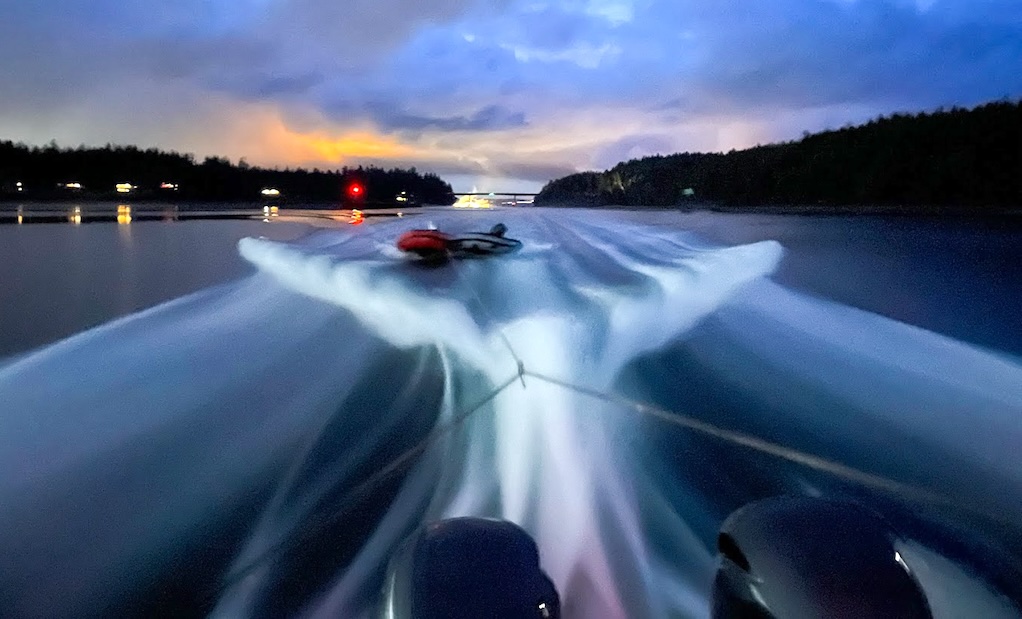
Two inflatable boats, Gray Boat and Red Boat, are towed behind the larger research vessel Fog Lark at twilight. The boats will be deployed to capture and release marbled murrelets to study their diet. Photo: Eric Wagner/PSI
Ament and I sit elbow to elbow on a large plastic crate full of gear, sweeping our spotlights back and forth from amidships to the bow. Every search I have ever been on starts this way: full of hope and optimism. Surely we will find murrelets. Surely they will pop up right in front of us. So we scan keenly, Ament and I. But our spotlights pass over bird-less green waters. Marbled murrelets are threatened for a reason, after all. That reason, at its most basic, is there are not very many of them. Especially in Washington, where their decline has been steepest. The realization starts to creep over us: we could be in for a long night.
Back and forth go our spotlights, back and forth. The hazy beams look like they reach for miles, but it is probably just fifty yards or so. The light both reveals and distorts. A floating branch with a bent twig looks like a bird. A small wave looks like a bird. Many small waves look like many birds. A feather floating on the water’s surface looks like eyeshine.
“You’ll get your search image right eventually,” Norris says, and in time we start to see actual birds. In the distance at first: some kind of small duck, some black and white and some smoky gray, maybe ten of them. They erupt out of the water and vanish into the night.
“Buffleheads,” Norris says. “We’ll see a lot of those.”
Ament next zeros in on another flock of squat black-and-white birds. Their heads pop up and they look this way and that. A few dive as Red Boat gets close; the rest run over the water, trying to take off, but they are heavy and their bellies bounce on the wavelets.
“Are those grebes?” Ament asks.
“Horned grebes,” Norris says. “We’ll see a lot of those, too.”
We motor on, see some brant geese, more buffleheads, some larger red-necked grebes. Then we come upon several common murres. These, being large auks, are at least in the same family as marbled murrelets. They dive after the light touches them, their dark shapes dematerializing underwater. A few minutes later, I catch a rhinoceros auklet in my beam. Norris slows Red Boat. “Rhinos are so easy,” he says. “Watch this.” We putter toward the auklet. Ament now holds her light on it. The auklet just sits there, mesmerized in the nexus of the beams. Does it even see us? The boat gets closer; the rhino still does not move. Now we are right on top of it; the bird is close enough to touch. I am tempted to reach out and grab it just because I can. When we are foot away, it finally dives, disappearing with a few powerful flicks of its wings.
“I wish all the birds were like rhinos,” Norris says. “But at least these are alcids. Just not the alcid we want.”
So close and yet so far. Still, we keep looking.
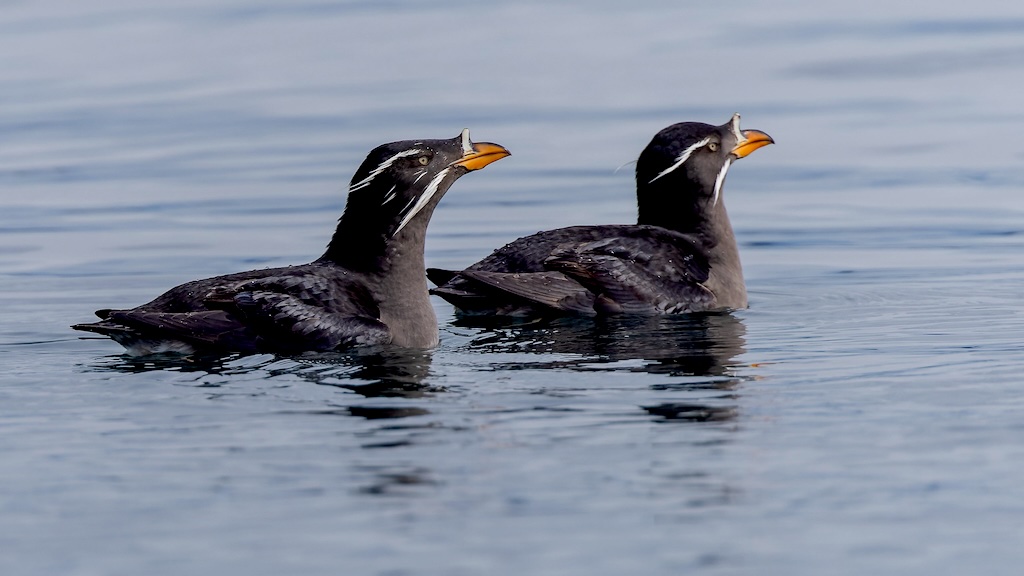
Rhinoceros auklets are much less elusive than marbled murrelets. Photo: Eric Ellingson (CC BY-NC-ND 2.0)
Pearson has been looking for murrelets for years now. Success is obviously never assured. He led a similar winter capture effort in 2018 and 2019 and caught six murrelets total, and four of those on a single night. (“Maybe I shouldn’t be telling you this,” he said when we were leaving Port Hadlock.) In the years since listing, the murrelets have shown curious regional dynamics. A recent report estimated the Washington population has declined by almost 60 percent over the past two decades, to fewer than 5,000 individuals. But in Oregon and California the numbers of murrelets may be stable, or even slightly increasing.
All of this lends a special urgency to Pearson’s project. Initially those night captures were simply to characterize the murrelet’s nonbreeding diet. This year, they are part of more comprehensive work aimed at revealing the murrelet’s winter habitat. The impetus is ecological. If we are lucky enough to catch a murrelet and get its feces, Pearson and his colleagues will then extract DNA to tell what kind of fish had passed through its gullet. That would tell them only part of the murrelet’s winter story here, though. A study published last year in Marine Ornithology, using data from the birds caught in 2018 and 2019, found that in Oregon and Washington, murrelets subsist mostly on Pacific herring. (In California, they eat more northern anchovy.) If the fecal DNA shows the fish is a herring, the question becomes whether the murrelet caught the herring because it was the only fish available? Or did the bird choose the herring from among a number of other species?
Over and above our labors, then, Pearson’s crews are out doing counts on the Strait of Juan de Fuca and Admiralty Inlet during the day, to get a sense of where the marbled murrelets are. After identifying areas of heightened murrelet density, a boat visits them to do an acoustics survey — in essence, a survey of all the life throughout the water column using the highest of high-end fish finders. The crew also collects seawater samples at varying depths — five meters, fifteen meters, and forty meters — so environmental DNA, or eDNA, can be extracted from it. This will tell them what organisms are either in the area or have passed through. At the same time, a fishing boat goes out and conducts a trawl, drawing from the water the bulk of what the acoustics survey detects.
All of this provides a sketch of the all the prey species from which the murrelet can choose — not just forage fish, like the herring, but other schooling invertebrates, like squid or crustaceans. In this chain of inquiry, the murrelets’ poop thus becomes a kind of dual end product: it is both the literal leavings of the bird’s most recent meal, and also a sign of the fish or food it caught for itself from the buffet available to it.
The issue, of course, is catching a murrelet so it can poop in the cardboard box. No one expects that to be easy, but part of what makes the dearth of birds on this cold night somewhat baffling is that, during daytime surveys, murrelets were here. Sometimes they were out and about by the hundreds. “Murrelets are fun to work with and hard to work with, since there’s still so much we don’t know,” Pearson says. “Why were they here during the day and not now? Even these basic things are a mystery.”
In cold pursuit
We continue up Marrowstone. One hour of puttering becomes two. We see more ducks, more grebes, but no murrelets. We pass a rock jutting out of the channel, a lump blacker than the water around it. When our lights pass, great globules of bright light blaze from it. It takes me a moment to realize those are the eyes of harbor seals that have hauled out for the night.
“Pretty cool, huh,” Norris says. “There’s a lot of stuff out here now, but you’d never know it looking out from land.”
The radio crackles then. “Red Boat, this is Gray Boat,” Pearson says. “I think we might have heard some calls. I’m going to do some playbacks to see if we can’t bring them in.”
“Okay,” Norris says. “Good luck.” From over the water we hear Pearson’s recording of murrelets calling to one another: a high, two-part whistle. If there are murrelets in the vicinity, this might prompt them to investigate, and so reveal themselves. We listen and move on; the whistles fade behind us. A few minutes later Norris gets back on the radio. “Gray Boat, this is Red Boat. Any luck?”
“Nope,” Pearson says. “We’re going to keep going.”
A terrestrial bias has tended to mark endangered species management, even among putatively marine species, like salmon. It is not hard to see why. Land is easier to fix.
We push past the northern tip of Marrowstone, out into the wider waters of the Strait of Juan de Fuca. The wind picks up a little; spray occasionally slops over the side of Red Boat. To our left are the lights of Port Townsend, warm and distant. We bypass them and turn south, towards the more severe bright wall of lights that represents the naval station on Indian Island.
“You kind of have to get used to this,” Norris says. “Just a lot of searching and not finding what you’re looking for.” And right as he says that, Ament’s and my beams pick up a host of shadowy figures of birds on the water — dozens of them. Norris immediately slows Red Boat. “Woah,” he says.
We drift into what is revealed to be a veritable scrum of birds. Ament and I move our lights slowly around, murmuring, cataloging what we see: buffleheads and scoters and horned grebes and western grebes and red-necked grebes and gulls. There must be hundreds of everything, more and more manifesting with beams’ reach as we float through their midst. Then the birds start to move, those in front of us lifting off and, giving the boat a wide berth, flying behind us and settling down again.
Nary a murrelet among them, at least so far as we can tell. We are left, then, to revel in the avian masses that stretch as far as we can see. They like something about this patch of water and are reluctant to leave it; and I am left with the feeling that we are awkward guests arriving at a party to which we were most definitely not invited.
Winter versus summer
In a way, there is something slightly — or perhaps even delightfully — contrarian about chasing murrelets in the dead of winter. Much research about the birds is tied to the spring and summer during the breeding season when murrelets nest inland in old growth trees. Now scientists and managers are busy trying to update and expand that view to include the winter seascapes as well as the summer landscapes.

During spring and summer, marbled murrelets sport plumage that is brown with flecks of white (left). In winter, their plumage is black and white as seen on a pair of nonbreeding juveniles on the right. Photos: Eric Ellingson (CC BY-NC-ND 2.0)
A terrestrial bias has tended to mark endangered species management, even among putatively marine species, like salmon. It is not hard to see why. Land is easier to fix. Where the murrelet is concerned, as hard as it is to preserve trees that take hundreds of years to reach a tiny bird’s desired size, the prospect of restoring or protecting the marine spaces on which that bird also depends is a much more daunting prospect.
Obviously the murrelets need trees in which to build their mossy nests, in which to lay their single eggs, in which to raise their single chicks. But those chicks need fish to eat, both when they are chicks, and later when they are adults. Adults also need fish and invertebrates to eat, not only when they are breeding, but when they are finished breeding (to recover), and before they breed again (to prepare themselves). None of that food comes from trees (at least not directly); and the sea is a more fluid space, physically, politically.
Among seabird biologists, an appreciation for what birds do during the nonbreeding season is a comparatively new line of inquiry. It is more straightforward to study a bird where it breeds, because it has to come to land to do that. Even the phrase “nonbreeding season” reveals a kind of semantic bias; birds during the winter are doing a lot more than merely not breeding. People are now learning how much what happens after the breeding season, or how much marine conditions in the nonbreeding season — often called “carry-over effects” — matter. A living murrelet is alive all the time, whether it is breeding or not breeding, whether it is flying dozens of miles from the Pacific to its nest, or floating in some mysterious part near Port Townsend. Or elsewhere.
"What's that?"
By around 11 p.m. or so, we have been tooling around for nearly five murrelet-less hours. Pearson decides our chances of success are approaching zero, so he calls off the search.
Norris points Red Boat towards Port Hadlock and we start back. None of us are terribly sorry to be going. It’s cold, we’re getting stiff. But Ament and I keep our spotlights swinging, even if we are fairly pro forma; little chance of us actually seeing anything.
Then, naturally, my light passes over something. “Wait, wait!” I call out. “What’s that?” Right at the edge of my beam is a small bird. Something in my mind perks up, notes that this bird looks different than all the other ones. It is lower in the water, somehow thinner, it holds its head in an upright way. I don’t know what it is, but it is different, and that is enough.
Norris cuts Red Boat’s engine, and we drift to a stop. “Where,” he asks. I point out the bird, which is staring back at us. Norris squints at it, leans forward; Ament does, too. “Gosh, that sure looks about right,” Norris says. “Keep your lights on it. I’ll try to get closer.”
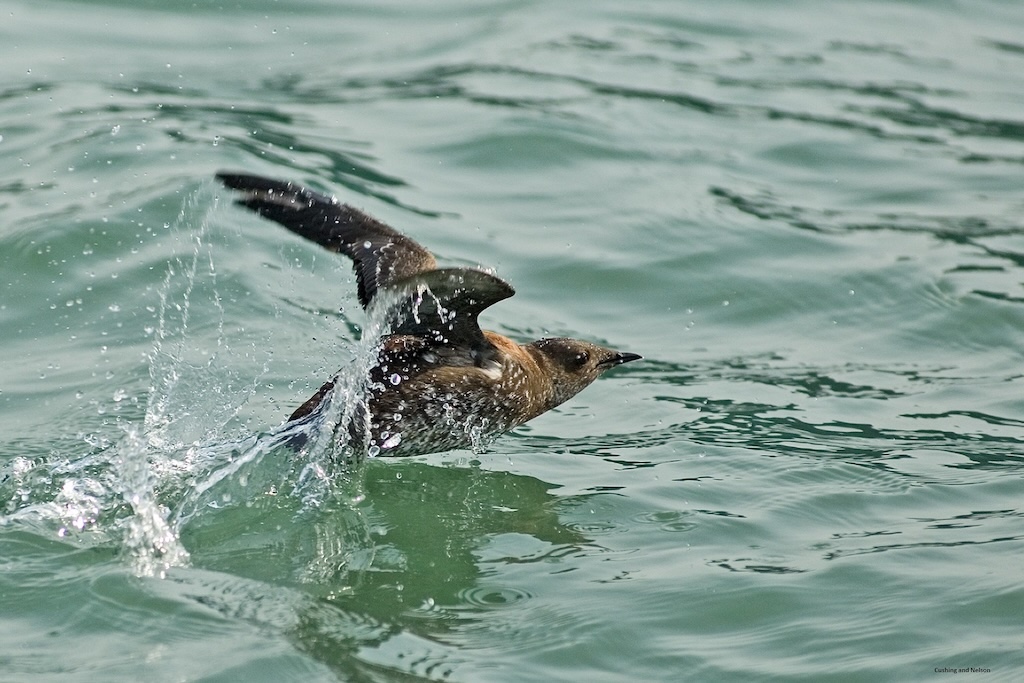
A marbled murrelet creates a splash as it takes flight. Kim Nelson, Oregon State University (CC BY-SA 2.0)
Ament swings her light over. Now we both have the bird. Norris gives the engine a little gas, and Red Boat starts to putter towards the bird. Maybe, if we get close enough, I’ll get to try to net something tonight after all. But when we are thirty yards away, the bird spooks and starts to run along the water, flapping, its wingtips smacking against the surface as it tries to generate enough speed to lift off.
“Shoot!” Norris says. He guns the engine and we lurch forward. Soon we are flying over the water, going as fast as Red Boat can carry us, but it is not near fast enough. The little bird’s wings are a blur, and now we can see that its body is clear of the water, and it is flying. Slowly it gains altitude and outpaces us, and then, to add insult to injury, it apparently realizes that it is far more maneuverable than we will ever be, because it turns slightly and vectors away.
“Hold it!” Norris commands. “Keep it in the light!” So Ament and I keep our beams trained on the little bird. But the murrelet is too fast, and fades as it reaches the diffuser ends of our beams. Fortunately, though, its tack is taking it towards Gray Boat, which is also on its way back to Port Hadlock.
Norris grabs the radio. “Gray Boat this is Red Boat! Gray Boat pick up!” he yells. “There’s a murrelet — I think it’s a murrelet! — Scott, it’s coming towards you! We’ve got it in our lights but we’re losing it! It’s too fast! Okay, now it’s going to go right over you! Gray Boat! Gray Boat, do you read? Try to follow it!” But spirited though Norris’ shouts are, Pearson must not hear him over the roar over Gray Boat’s motor, because their course does not change in the slightest, and the murrelet, or whatever it is, flies over them unremarked upon, and disappears into the night.
